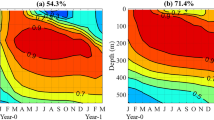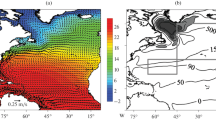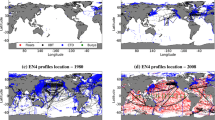Abstract
An ocean analysis, assimilating both surface and subsurface hydrographic temperature data into a global ocean model, has been produced for the period 1958–2000, and used to study the time and space variations of North Atlantic upper ocean heat content (HC). Observational evidence is presented for interannual-to-decadal variability of upper ocean thermal fluctuations in the North Atlantic related to the North Atlantic Oscillation (NAO) variability over the last 40 years. The assimilation scheme used in the ocean analysis is a univariate, variational optimum interpolation of temperature. The first guess is produced by an eddy permitting global ocean general circulation forced by atmospheric reanalysis from the National Center for Environmental Prediction (NCEP). The validation of the ocean analysis has been done through the comparison with objectively analyzed observations and independent data sets. The method is able to compensate for the model systematic error to reproduce a realistic vertical thermal structure of the region and to improve consistently the model estimation of the time variability of the upper ocean temperature. Empirical orthogonal function (EOF) analysis shows that an important mode of variability of the wintertime upper ocean climate over the North Atlantic during the period of study is characterized by a tripole pattern both for SST and upper ocean HC. A similar mode is found for summer HC anomalies but not for summer SST. Over the whole period, HC variations in the subtropics show a general warming trend while the tropical and north eastern part of the basin have an opposite cooling tendency. Superimposed on this linear trend, the HC variability explained by the first EOF both in winter and summer conditions reveals quasi-decadal oscillations correlated with changes in the NAO index. On the other hand, there is no evidence of correlation in time between the NAO index and the upper ocean HC averaged over the whole North Atlantic which exhibits a substantial and monotonic warming trend during the last two decades of the analysis period. The maximum correlation is found between the leading principal component of winter HC anomalies and NAO index at 1 year lag with NAO leading. For SST anomalies significant correlation is found only for winter conditions. In contrast, for HC anomalies high correlations are found also in the summer suggesting that the summer HC keeps a memory of winter conditions.
















Similar content being viewed by others
References
Alexander MA, Deser A (1995) A mechanism for the recurrence of wintertime SST anomalies. J Phys Oceanogr 25: 122–137
Bretherton FR, Davis RE, Fandry CB (1976) A technique for objective analysis and design of oceanographic experiment applied to MODE-73. Deep Sea Res 37: 559–582
Carter EF, Robinson AR (1987) Analysis models for the estimation of oceanic fields. J Atmos Oceanic Technol 4: 49–74
Carton JA, Chepurin G, Cao X (2000) A simple ocean data assimilation analysis of the global upper ocean 1950–95. Part I: methodology. J Phys Oceanogr 30: 294–309
Conkright ME, Levitus S, O’Brein T, Stephen C, Stathoplos L, Baranova O, Antonov J, Gelfeld R, Burney J, Rochester J, Forgy C (1998) World Ocean Database 1998. Documentation and Quality Control. Version 2.1. National Oceanographic Data Center Internal Report 14 OCL/NODC
Cox MD (1984) A primitive equation, 3-dimensional model of the ocean. GFDL Ocean Group Tech Rep 1, pp 143
Curry RG, McCartney MS (2001) Ocean gyre circulation associated with the North Atlantic Oscillation. J Phys Oceanogr 31: 3374–3400
Curry RG, McCartney MS, Joyce TM (1998) Oceanic transport of subpolar climate signals to mid-depth subtropical waters. Nature 391:575–577
Deser C, Blackmon ML (1993) Surface climate variations over the North Atlantic Ocean during winter: 1900–1989. J Clim 6: 1743–1753
Deser C, Alexander AM, Timlin MS (2003) Understanding the persistence of sea surface temparature anomalies in midlatitudes. J Clim 16: 57–72
Frankignoul C, De Coëtlogon G, Joyce TM, Dong S (2001) Gulf Stream variability and ocean-atmosphere interactions. J Phys Oceanogr 31: 3516–3528
Grey SM, Haines K, Troccoli A (2000) A study of temperature changes in the upper North Atlantic: 1950–94. J Clim 13: 2697–2711
Hansen DV, Bezdek HF (1996) On the nature of decadal anomalies in North Atlantic sea surface temperature. J Geophys Res 101: 48,749–48,758
Houghton RW (1996) Subsurface quasi-decadal fluctuations in the North Atlantic. J Clim 9: 1363–1373
Joyce MT, Deser C, Spall MA (2000) The relation between decadal variability of subtropical mode water and the North Atlantic Oscillation. J Clim 13: 2550–2569
Krahmann G, Visbeck M, Reverdin G (2001) Formation and propagation of temperature anomalies along the North Atlantic Current. J Phys Oceanogr 31: 1287–1303
Kushnir Y (1994) Interdecadal variations in North Atlantic sea surface temperature and associated atmospheric conditions. J Clim 7: 141–157
Levitus S (1989) Interpentadal variability of temperature and salinity at intermediate depths of the North Atlantic Ocean, 1970–1974 versus 1955–1959. J Geophys Res 94: 6091–6131
Levitus S, Antonov JI, Boyer TP (1994) Interannual variability of temperature at a depth of 125 meters in the North Atlantic Ocean. Science 266: 96–99
Levitus S, Antonov JI, Boyer TP, Stephens C (2000) Warming of the World Ocean. Science 287: 2225–2229
Marshall JC, Nurser AJG, Williams RG (1993) Inferring the subduction rate and period over the North Atlantic. J Phys Oceanogr 23: 1315–1329
Masina S, Pinardi N, Navarra A (2001) A global ocean temperature and altimeter data assimilation system for studies of climate variability. Clim Dyn 17: 687–700
Mellor GL, Yamada T (1982) Development of a turbulence closure model for geophysical fluid problems. Rev Geophys Space Phys 20: 851–875
Molinari RL, Mayer DA, Festa JF, Bezdek HF (1997) Multi-year variability in the nearsurface temperature structure of the midlatitude western North Atlantic Ocean. J Geophys Res 102: 23,267–23,278
Rayner NA, Kent EC, Kaplan A (2003) Global analyses of sea surface temperature, sea ice, and night marine air temperature since the late nineteenth century. J Geophys Res 108: No. D14, 4407, doi:10.1029/2002JD002670
Rosati A, Miyakoda K (1988) A general circulation model for upper ocean simulations. J Phys Oceanogr 18: 1601–1626
Smagorinsky J (1993) Some historical remarks on the use of nonlinear viscosities. In: Galperin B, Orzag SA (eds) Large eddy simulation of complex engineering and geophysical flows. Cambridge University Press, Cambridge, UK, pp 3–36
Stammer D, Wunsch C, Giering R, Eckert C, Heimbach P, Marotzke J, Adcroft A, Hill CN, Marshall J (2003) Volume, heat, and freshwater transport of the global ocean circulation 1993–2000, estimated from a general circulation model constrained by World Ocean Circulation Experiment (WOCE) data. J Geophys Res 108: No. C1, 3007, doi:10.1029/2001JC001115
Sutton RT, Allen MR (1997) Decadal predictability in Gulf Stream sea surface temperature. Nature 388: 563–567
Talley LD, Raymer ME (1982) Eighteen degree water variability. J Mar Res 40 (Suppl.): 757–777
Watanabe M, Kimoto M (2000) On the persistence of decadal SST anomalies in the North Atlantic. J Clim 13: 3017–3028
Watanabe M, Kimoto M, Nitta T, Kachi M (1999) A comparison of decadal climate oscillations in the North Atlantic detected in observations and a coupled GCM. J Clim 12: 2920–2940
Williams RG, Spall MA, Marshall JC (1995) Does Stommel’s mixed layer “Demon” work? J Phys Oceanogr 25: 3089–3102
Acknowledgements
This work has been supported by the EU PREDICATE Project (Contract EVK2-CT-1999-00020) and the EU ENACT Project (Contract EVK2-CT2001-00117). Helpful comments and suggestions were provided by two anonymous reviwers.
Author information
Authors and Affiliations
Corresponding author
Rights and permissions
About this article
Cite this article
Masina, S., Di Pietro, P. & Navarra, A. Interannual-to-decadal variability of the North Atlantic from an ocean data assimilation system. Climate Dynamics 23, 531–546 (2004). https://doi.org/10.1007/s00382-004-0453-6
Received:
Accepted:
Published:
Issue Date:
DOI: https://doi.org/10.1007/s00382-004-0453-6




